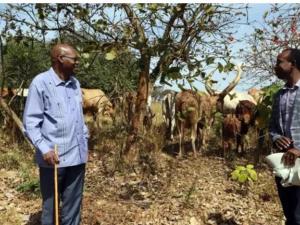
Gako meat project takes shape as Rwanda eyes foreign market
The Gako meat project has started producing meat and supplying to the local market, and works to bring the initiative to full capacity are underway, its managers have said.
It is Rwanda’s flagship project to increase quality meat production for local and export markets, according to its developers.
They were speaking on Thursday, July 14, as the president of the Senate, Augustin Iyamuremye visited the project– Gako Meat Company Ltd, in Bugesera District.
Birasa Nyamulinda, CEO of the firm said they started selling beef from the project to the local market last year in November with between six and eight cows slaughtered per week.
He added that sales have since increased to between 30 and 40 carcasses in a week.
Based on the observation made, he said that the weight of the carcass varies from 200 kilogrammes and 600 kilogrammes, with the average weight estimated at 250 kilogramme.
He explained that weight depends on the farming practices including feeding, the type of the breed in question as well as age of the cow, pointing out that they are investing in efforts to maximise the weight.
Currently, the meat is being supplied to buyers including Simba Supermarket and, according to Solange Uwituze, Deputy Director General in charge of Animal Resources Development at Rwanda Agriculture and Animal Resources Board (RAB).
Project capacity
Initiated in 2014, the meat project faced challenges including the investors who would execute it falling short of the required financing. This hindered its production. In 2020, the Government of Rwanda decided to venture into it in the project order to enliven it up.
As such, it is a public private partnership implemented under the Gako Meat Company Ltd. The Government of Rwanda has 52 percent of the shares in the project, while Cattle Ville Ranchers takes 31 percent and Gako Beef Company (comprising the 13 investors) which accounts for 17 percent.
The project, which covers 6,000 hectares, plans to have 56,000 cows in feedlots for fattening, Uwituze said. So far, she said, it has over 5,000 cows.
Birasa indicated that they are targeting to slaughter 86,400 cows per year, explaining that this will be achieved progressively, indicating that they expect to have reached that number in three years.
Currently, Rwanda’s annual meat production stands at 176,000 tonnes, according to data from RAB.
Investment, market and return
Initially, the project investment was estimated at $62 million (about Rwf63 billion), but it was later increased to $73 million (about Rwf74 billion), Birasa said.
Explaining the reason for the increase in the project investment, Birasa indicated that it was due to the inclusion of the in-field irrigation for watering fodder for sustainability in cow feeding and cattle production especially during dry season.
This component, which was not factored in before, is currently estimated at Rwf12.8 billion in investment, he indicated.
He explained that the irrigation scheme is being developed and is expected to be ready for irrigating fodder in February next year (2023).
Senate President, Augustin Iyamuremye said effective implementation of this project should be ensured.
“If this project works well, Rwanda can be self-reliant in meat production, but also have a surplus for the export market,” he said, adding that meat produced in open areas where cows graze is sought after for human consumption in some countries.
However, he asked the project developers how the money being invested in the project would be recovered and the return on investment.
Uwituze said that the project business plan indicates that the markets they are targeting are mainly in the Gulf countries such as Qatar, and regional [French-speaking countries in Central Africa] such as Angola, Congo [Brazzaville], Central African Republic where a kilogramme of beef is relatively expensive as it costs $15 (over Rwf15,000).
“This is an easy to access market, and RwandAir flies there,” she said, adding that the business plan showed that the country could break even on the Rwf74 billion investment after four years. These years, Uwituze explained, are counted from 2023 when the needed production factors including infrastructures will be in place.
She said that they plan to set up an abattoir with a capacity to slaughter 200 cows per hour, adding that they will expand it based on the market demand and penetration.
Later, she said that the country will seek to penetrate the European market.
https://www.newtimes.co.rw/news/gako-meat-project-takes-shape-rwanda-eye...
